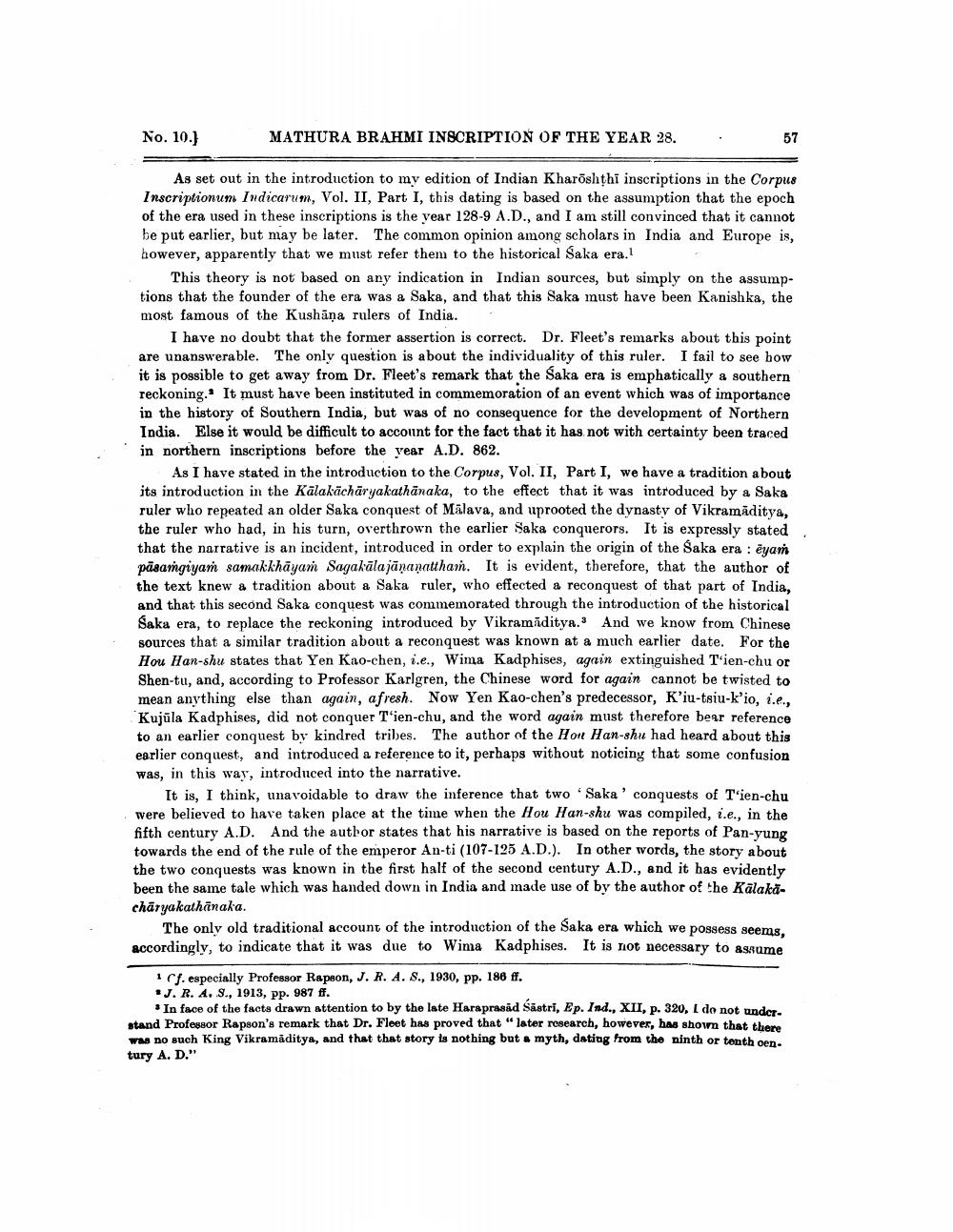________________
No. 10.)
MATHURA BRAHMI INSCRIPTION OF THE YEAR 28.
57
As set out in the introduction to my edition of Indian Kharöshthi inscriptions in the Corpus Inscriptionum Indicarum, Vol. II, Part I, this dating is based on the assumption that the epoch of the era used in these inscriptions is the year 128-9 A.D., and I am still convinced that it cannot be put earlier, but may be later. The common opinion among scholars in India and Europe is, however, apparently that we must refer them to the historical Saka era.
This theory is not based on any indication in Indian sources, but simply on the assumptions that the founder of the era was a Saka, and that this Saka must have been Kanishka, the most famous of the Kushāņa rulers of India.
I have no doubt that the former assertion is correct. Dr. Fleet's remarks about this point are unanswerable. The only question is about the individuality of this ruler. I fail to see how it is possible to get away from Dr. Fleet's remark that the Saka era is emphatically & southern reckoning. It must have been instituted in commemoration of an event which was of importance in the history of Southern India, but was of no consequence for the development of Northern India. Else it would be difficult to account for the fact that it has not with certainty been traced in northern inscriptions before the year A.D. 862.
As I have stated in the introduction to the Corpus, Vol. II, Part I, we have a tradition about its introduction in the Kālakāchāryakathānaka, to the effect that it was introduced by a Saka ruler who repeated an older Saka conquest of Mālava, and uprooted the dynasty of Vikramaditya, the ruler who had, in his turn, overthrown the earlier Saka conquerors. It is expressly stated that the narrative is an incident, introduced in order to explain the origin of the Saka era : @yam pāsamgiya samakkhāyam Sagakālajānanattham. It is evident, therefore, that the author of the text knew a tradition about a Saka ruler, who effected a reconquest of that part of India, and that this second Saka conquest was commemorated through the introduction of the historical Saka era, to replace the reckoning introduced by Vikramiditya. And we know from Chinese sources that a similar tradition about a reconquest was known at a much earlier date. For the Hou Han-shu states that Yen Kao-chen, i.e., Wima Kadphises, again extinguished T‘ien-chu or Shen-tu, and, according to Professor Karlgren, the Chinese word for again cannot be twisted to mean anything else than again, afresh. Now Yen Kao-chen's predecessor, K'iu-tsiu-k'io, ie, Kujūla Kadphises, did not conquer T'ien-chu, and the word again must therefore bear reference to an earlier conquest by kindred tribes. The author of the Hont Han-shu had heard about this earlier conquest, and introduced a reference to it, perhaps without noticing that some confusion was, in this way, introduced into the narrative.
It is, I think, unavoidable to draw the inference that two 'Saka' conquests of T'ien-chu were believed to have taken place at the time when the Hou Han-shu was compiled, i.e., in the fifth century A.D. And the author states that his narrative is based on the reports of Pan-yung towards the end of the rule of the emperor An-ti (107-125 A.D.). In other words, the story about the two conquests was known in the first half of the second century A.D., and it has evidently been the same tale which was handed down in India and made use of by the author of the Kālakachāryakathānaka.
The only old traditional account of the introduction of the Saka era which we possess seems. accordingly, to indicate that it was due to Wima Kadphises. It is not necessary to assume
1 cf. especially Professor Rapson, J. R. A. S., 1930, pp. 186 ff. *J. R. A.S., 1913, pp. 987 ff.
* In face of the facts drawn attention to by the late Haraprasad Sastri, Ep. Ind., XII, p. 320, I do not under. stand Professor Rapson's remark that Dr. Fleet has proved that "later research, however, has shown that there was no such King Vikramaditya, and that that story is nothing but a myth, dating from the ninth or tenth cen. tury A. D."




